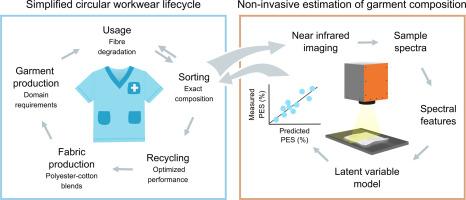Hyperspectral imaging quantifies blend composition change in workwear textiles
IF 6.4
Q1 ENVIRONMENTAL SCIENCES
引用次数: 0
Abstract
Textile blends are challenging to recycle due to usage of multiple different blend percentages, but also due to composition change caused by fiber degradation over time. This is particularly crucial for workwear, which must meet strict performance and safety requirements. This paper discusses estimating blend composition changes using near infrared hyperspectral imaging. We analyzed 30 used hospital workwear garments with known number of laundering cycles and identical polyester-cotton blend composition at production. A latent variable regression model, based on hyperspectral data, estimated their current composition, which was determined using ISO-standardized chemical analysis. Results showed that near infrared hyperspectral imaging accurately estimated composition changes, with a root mean squared error below 0.5 wt-%, compared to over 1.4 wt-% error when utilizing the number of laundering cycles for estimation. Our approach could be used as a quality control method in sorting, leading to more granular sorted fractions, facilitating increased workwear recycling rates.

高光谱成像量化工作服纺织品中混纺成分的变化
由于使用多种不同的混纺百分比,而且由于纤维随时间降解而引起的成分变化,纺织混纺物的回收具有挑战性。这对于工作服尤其重要,因为它必须满足严格的性能和安全要求。本文讨论了利用近红外高光谱成像估计混合成分变化的方法。我们分析了30件已知洗涤次数和相同涤棉混纺成分的医院工作服。基于高光谱数据的潜变量回归模型估计了它们的当前成分,这是通过iso标准化化学分析确定的。结果表明,近红外高光谱成像准确地估计了成分的变化,其均方根误差低于0.5 wt-%,而使用洗涤周期数进行估计时的误差超过1.4 wt-%。我们的方法可以用作分拣的质量控制方法,导致更颗粒的分拣分数,促进提高工作服的回收率。
本文章由计算机程序翻译,如有差异,请以英文原文为准。
求助全文
约1分钟内获得全文
求助全文
来源期刊

Resources, conservation & recycling advances
Environmental Science (General)
CiteScore
11.70
自引率
0.00%
发文量
0
审稿时长
76 days
 求助内容:
求助内容: 应助结果提醒方式:
应助结果提醒方式:


